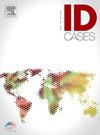Pyogenic vertebral osteomyelitis and iliopsoas muscle abscess caused by non-typhoidal Salmonella rapidly identified by genetic testing in an immunocompetent teenage boy without hemoglobinopathies
IF 1.1
Q4 INFECTIOUS DISEASES
引用次数: 0
Abstract
Vertebral osteomyelitis caused by non-typhoidal Salmonella spp. is exceedingly rare, particularly among immunocompetent children. This report presents an unusual case of lumbar osteomyelitis and an iliopsoas muscle abscess caused by non-typhoidal Salmonella in an immunocompetent pediatric patient with a multidrug allergy. A 13-year-old boy presented with fever and lumbar pain. Diagnostic imaging revealed lumbar osteomyelitis and an iliopsoas abscess. Blood culture and initial iliopsoas puncture tissue sample test results were negative. Therefore, cefazolin was administered as empirical therapy for covering typical organisms such as Staphylococcus aureus and Streptococcus species causing vertebral osteomyelitis in healthy children. However, genetic testing of the biopsy sample of the vertebral tissue subsequently identified Salmonella spp. as the causative agent. Culture of the vertebral tissue also yielded Salmonella spp., with the O-antigen identified as type 4. Antibiotic selection was challenging because of the patient's drug allergies and age. Treatment was commenced with ceftriaxone and later changed to ampicillin owing to adverse drug reactions. The side effects, such as rash, fever, and nausea, persisted after switching to oral sulfamethoxazole-trimethoprim, which was later changed to amoxicillin. Although the treatment duration of vertebral Salmonella osteomyelitis in children is not standardized, we treated the patient for 9 weeks based on previously reported evidence. Rapid identification of the causative organism is important because vertebral osteomyelitis requires long-term treatment and treatment options may be limited, particularly in pediatric patients. Physicians should consider genetic testing to identify the causative organism of osteomyelitis.
由非伤寒沙门氏菌引起的化脓性椎体骨髓炎和髂腰肌脓肿,通过基因检测在无血红蛋白病的免疫功能正常的青少年中迅速鉴定出来
由非伤寒沙门氏菌属引起的椎骨骨髓炎极为罕见,尤其是在免疫功能正常的儿童中。本报告介绍了一例由非伤寒沙门氏菌引起的腰椎骨髓炎和髂腰肌脓肿的罕见病例,该病例的儿童免疫功能正常,且对多种药物过敏。一名 13 岁男孩因发烧和腰痛就诊。诊断性影像学检查发现他患有腰椎骨髓炎和髂腰肌脓肿。血液培养和最初的髂腰肌穿刺组织样本检测结果均为阴性。因此,医生采用头孢唑啉作为经验疗法,以覆盖引起健康儿童椎体骨髓炎的典型病菌,如金黄色葡萄球菌和链球菌。然而,随后对椎体组织活检样本进行的基因检测确定沙门氏菌为致病菌。椎体组织的培养也发现了沙门氏菌属,其 O 抗原被确定为 4 型。由于患者对药物过敏且年龄较大,因此抗生素的选择具有挑战性。治疗开始时使用头孢曲松,后因药物不良反应改用氨苄西林。改用口服磺胺甲噁唑-三甲氧苄青霉素后,皮疹、发烧和恶心等副作用依然存在,后来又改用阿莫西林。虽然儿童椎体沙门氏菌骨髓炎的治疗时间没有统一标准,但我们根据之前报道的证据对患者进行了为期 9 周的治疗。快速确定致病菌非常重要,因为椎体骨髓炎需要长期治疗,而治疗方案可能有限,尤其是对儿童患者而言。医生应考虑通过基因检测来确定骨髓炎的致病菌。
本文章由计算机程序翻译,如有差异,请以英文原文为准。
求助全文
约1分钟内获得全文
求助全文

 求助内容:
求助内容: 应助结果提醒方式:
应助结果提醒方式:


